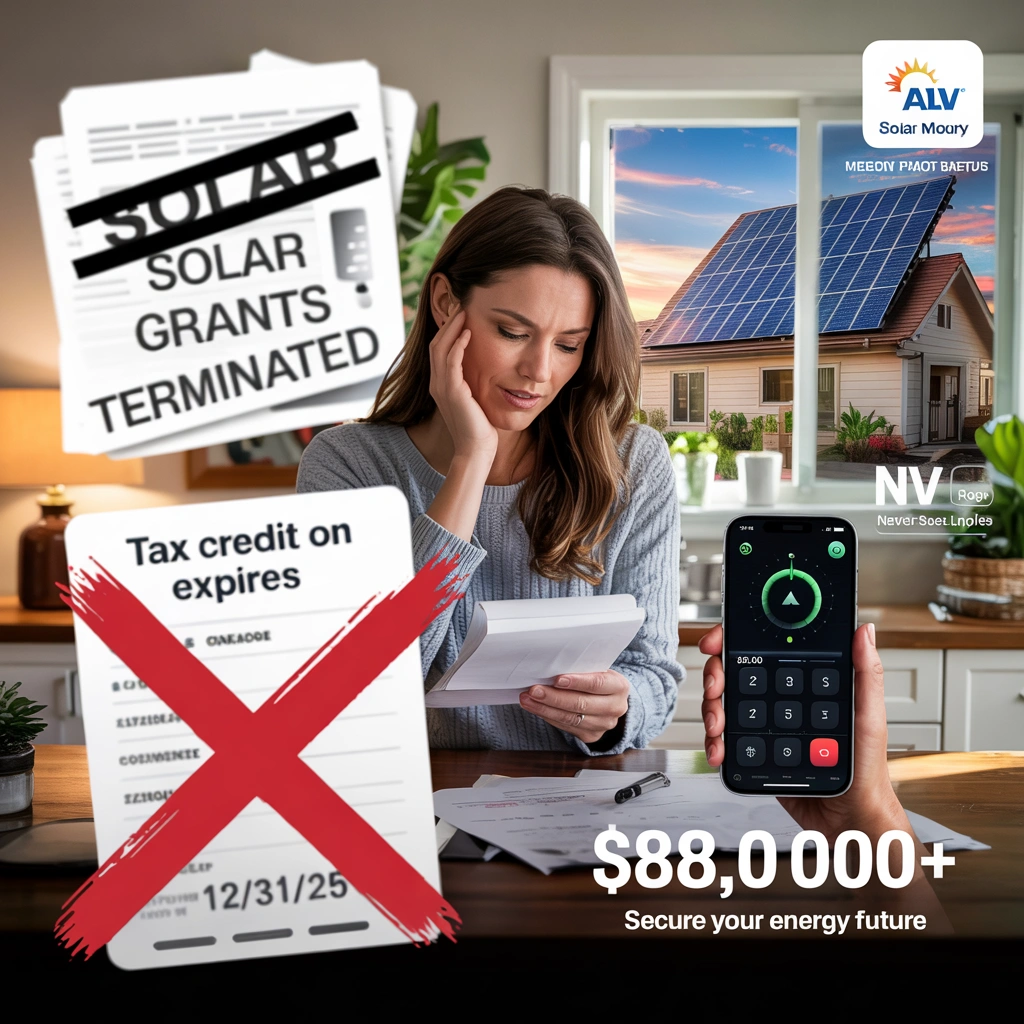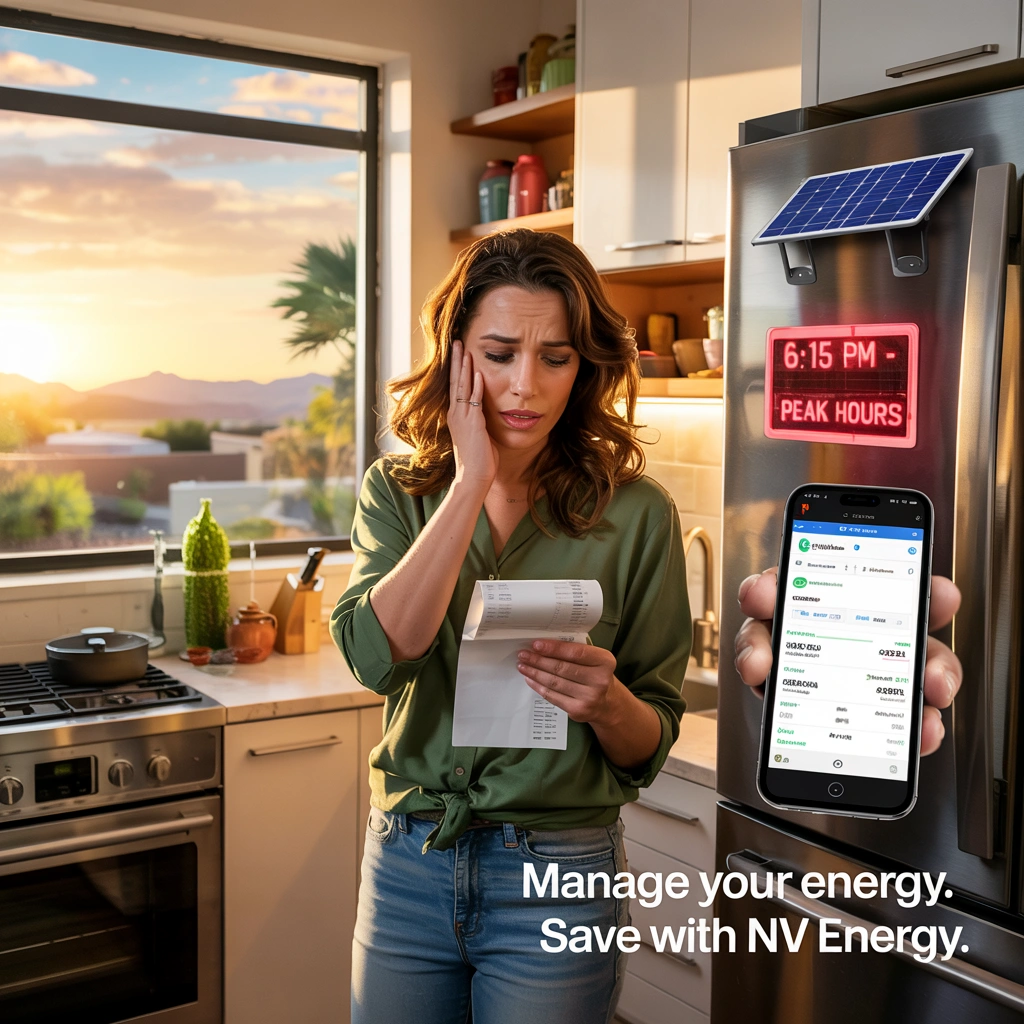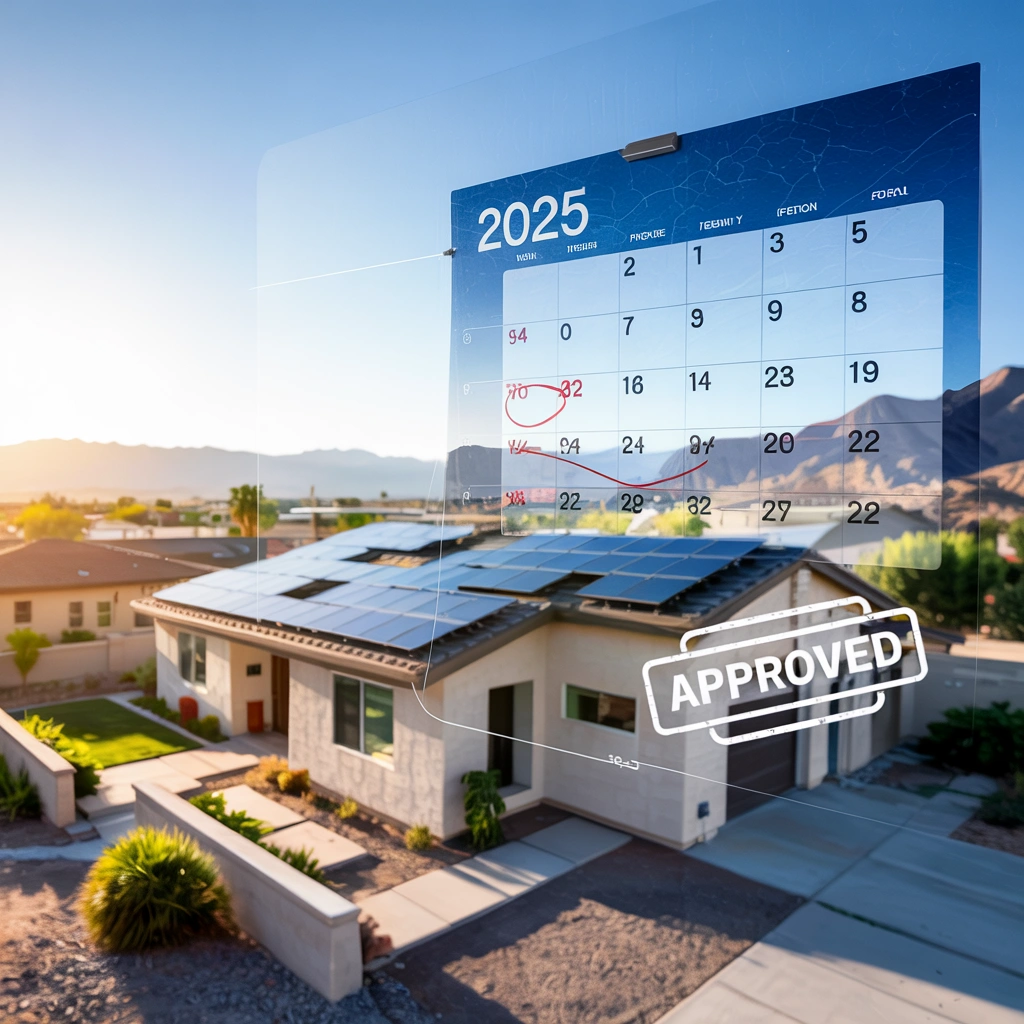
Summary: Nevada’s new utility demand charges could add $27-$38 to monthly bills starting April 2026, but AI-powered solar systems are now delivering 25-35% cost reductions through predictive maintenance. Here’s how the math is changing for homeowners.
Key Takeaways:
- Despite the termination of Nevada’s solar grant programs and federal tax credit changes, solar investment remains financially sound due to falling equipment costs and rising utility rates
- AI-powered solar systems now offer smart energy management, predictive maintenance, reducing costs by 25-35%, and real-time optimization that adapts to environmental conditions
- NV Energy’s April 2026 demand charges may add $27-$38 monthly to utility bills, making solar’s peak-hour generation even more valuable
- Nevada homeowners can save approximately $40,000 over their solar system’s 25-30 year lifetime, with protection against escalating utility rates
- Strategic timing and expert guidance help homeowners navigate complex solar decisions while avoiding costly mistakes
Nevada homeowners face a challenging landscape: government solar programs disappearing, federal tax credits changing, and utility bills climbing relentlessly. Yet this environment reveals why solar has evolved beyond dependence on government incentives into a robust, technology-driven investment opportunity.
The fundamentals driving solar value—artificial intelligence optimization, predictive maintenance systems, and protection against rising electricity costs—create compelling economics that persist regardless of political changes. Nevada’s abundant sunshine, ranking among the top states nationally for solar potential, combined with above-average electricity costs, establishes the foundation for long-term energy savings.
Nevada Maintains Solar Incentives Despite Federal Changes
Nevada continues supporting solar adoption through net metering policies and streamlined permitting processes, even as federal programs face uncertainty. The state’s regulatory framework allows homeowners to receive credits for excess solar generation, though new installations receive 75% of retail rates rather than full retail pricing. This structure still provides meaningful bill reduction while encouraging system sizing that matches actual consumption patterns.
State-level consistency becomes increasingly valuable as federal policies shift. Nevada’s Public Utilities Commission maintains predictable rules that help homeowners make informed investment decisions. The regulatory stability contrasts sharply with terminated grant programs, demonstrating how state-managed incentives often prove more reliable than federal initiatives subject to political changes.
Federal Tax Credits Face Changes
The federal solar tax credit currently provides 30% savings through 2032, then steps down to 26% in 2033 and 22% in 2034. This creates urgency for homeowners considering solar installations to maximize available incentives. For a typical 5 kW Nevada installation, this represents approximately $3,349 in current savings.
Equipment Costs Drop Significantly in the Last Decade
Solar panel prices have plummeted dramatically due to manufacturing improvements and global competition. High-efficiency panels now convert 20-22% of sunlight to electricity, with premium models exceeding 23% efficiency. These advances mean homeowners get more power generation from smaller roof areas, maximizing return on investment even with changing tax incentives.
Installation costs continue declining as contractors streamline processes and permitting becomes more efficient. Soft costs—including sales, permitting, and inspection fees—represent decreasing percentages of total system prices. These reductions help offset potential changes to federal tax credits while improving overall project economics.
Solar Economics Strengthen Beyond Government Support
Market-driven improvements create sustainable solar economics independent of government support. Competition among manufacturers drives innovation, while installation competition reduces labor costs. The average Nevada solar payback period of approximately 10 years reflects these improved fundamentals, comparing favorably to the national average despite regulatory changes.
Financing options expand as solar becomes mainstream. Zero-down solar loans, PACE programs, and home equity lines provide accessible pathways to solar ownership. These market-based solutions replace government grants with private capital, creating more stable and predictable access to solar investment opportunities.
AI Technology Transforms Solar Performance
Artificial intelligence revolutionizes how solar systems operate, learn, and optimize performance. Modern installations incorporate machine learning algorithms that continuously improve efficiency based on weather patterns, household consumption habits, and grid conditions. This intelligence transforms static solar arrays into dynamic energy systems that adapt and improve over time.
1. Smart Energy Management Systems Balance Real-Time Output
AI-powered inverters monitor individual panel performance while optimizing energy flow throughout the system. These systems detect shading impacts, temperature variations, and equipment issues instantly, adjusting operations to maintain peak efficiency. Smart management extends beyond basic power conversion to include battery coordination, grid interaction, and load balancing based on time-of-use pricing structures.
Machine learning algorithms analyze household energy patterns to predict consumption and align solar production accordingly. The system learns when air conditioning peaks, when electric vehicle charging occurs, and how seasonal variations affect energy needs. This intelligence enables precise battery charging schedules and optimal grid interaction timing.
2. Predictive Maintenance Reduces Costs by 25-35%
AI-based monitoring systems identify potential equipment problems before failures occur, reducing maintenance costs and preventing production losses. Algorithms analyze performance data to predict inverter issues, panel degradation, and wiring problems months in advance. Early detection prevents small issues from becoming expensive repairs while maximizing system uptime.
Remote diagnostics solve many problems without service visits, reducing maintenance expenses significantly. Professional solar consultants help homeowners understand these advanced monitoring capabilities while ensuring systems deliver promised performance levels. Predictive maintenance transforms solar from reactive repairs to proactive optimization, improving long-term returns substantially.
3. Real-Time Optimization Adapts to Environmental Conditions
Advanced solar systems integrate weather forecasting data to optimize energy production and storage decisions. AI algorithms predict cloud cover, temperature variations, and storm patterns to maximize energy capture during optimal conditions. This intelligence helps battery systems prepare for grid outages while ensuring adequate stored power for household needs.
Real-time optimization considers multiple variables simultaneously: current weather conditions, utility rate structures, household consumption patterns, and grid demand. The system makes thousands of micro-adjustments daily, fine-tuning performance to maximize economic returns while maintaining a reliable power supply.
NV Energy’s April 2026 Demand Charges Impact Bills
Nevada’s largest utility implements new pricing structures designed to recover grid infrastructure costs from residential customers. These changes fundamentally alter how homeowners pay for electricity, shifting from simple per-kilowatt-hour charges to complex demand-based pricing that penalizes peak usage periods.
Daily Peak Usage Charges 18 Cents Per Kilowatt
NV Energy’s demand charge structure identifies each customer’s highest 15-minute power usage during peak hours and applies an 18-cent daily charge for each kilowatt of peak demand. Air conditioning, electric vehicle charging, and multiple appliances running simultaneously create these expensive peak demand periods that compound monthly utility costs.
Solar systems generate maximum power during peak demand hours when electricity costs most under the new rate structure. This timing alignment creates substantial savings opportunities as solar production directly offsets the most expensive electricity usage periods. Battery storage systems multiply these benefits by storing solar power for use during peak pricing periods.
Consumer Advocates Warn of $27-$38 Monthly Increases
Independent analysis suggests typical Nevada households could see monthly bill increases between $27-$38 under the new demand charge structure, though NV Energy states the changes restructure existing bills rather than increase total costs. These potential increases compound over time as infrastructure costs continue rising, creating predictable upward pressure on utility rates that makes fixed solar costs increasingly attractive.
The demand charge structure particularly impacts households with variable usage patterns—families with teenagers, remote workers, or electric vehicle owners face the highest potential increases. Solar combined with battery storage helps flatten these demand peaks, reducing exposure to the most expensive rate components while maintaining household comfort and convenience.
Nevada Homeowners Save Approximately $40,000 Over System Lifetime
Long-term financial analysis reveals substantial savings potential for Nevada solar installations. The average homeowner with a properly sized system saves approximately $40,000 over 25 years, accounting for system costs, maintenance expenses, and electricity price inflation. These calculations assume modest 2-3% annual utility rate increases, though actual increases often exceed these conservative projections.
25-Year Solar Panel Warranties with 30-Year Performance
Modern solar panels carry detailed 25-year performance warranties guaranteeing at least 80% of original output after two decades. Many panels continue producing electricity efficiently for 30+ years, extending savings beyond warranty periods. This longevity transforms solar from a short-term expense into decades of predictable energy cost control.
Warranty protection covers manufacturing defects, performance degradation, and weather damage, providing financial security for long-term investments. Premium manufacturers offer enhanced warranties with higher performance guarantees, reflecting confidence in product reliability and durability under Nevada’s intense sun exposure.
Protection Against Escalating Utility Rates
Solar systems provide inflation protection by fixing energy costs at installation levels while utility rates climb annually. Nevada electricity prices have increased significantly over recent years, a trend likely to continue as infrastructure improvements and renewable energy mandates increase utility operating costs.
Fixed solar payments create predictable budgeting advantages compared to volatile utility bills. Homeowners know their energy costs years in advance, enabling better financial planning and protection against unexpected rate increases. This predictability becomes increasingly valuable as utility pricing structures grow more complex and expensive.
Energy Independence Addresses Nevada’s Growing Grid Strain
Nevada’s electrical grid faces mounting pressure from population growth, extreme weather events, and aging infrastructure. The Las Vegas area population continues to expand while summer temperatures reach record levels, creating unprecedented demand for electricity during peak cooling periods. Solar with battery backup provides household-level solutions to grid reliability challenges.
Individual energy independence reduces collective grid stress while providing personal protection against outages. As more households install solar and battery systems, neighborhood grid stability improves through distributed generation and reduced peak demand. This creates positive spillover effects that benefit entire communities through improved electrical infrastructure resilience.
Battery storage systems offer complete energy independence during outages while reducing grid dependence during normal operations. Modern lithium batteries provide 10-15 years of reliable service with minimal maintenance requirements. Emergency backup capabilities prove especially valuable during Nevada’s summer months when grid failures can create dangerous conditions for vulnerable populations.
Solar Investment Delivers Value With or Without Incentives
The solar investment case rests on fundamental economics rather than temporary government programs. Equipment cost reductions, technology improvements, and rising utility rates create compelling financial returns that persist regardless of political support. Nevada’s exceptional solar resource—ranking among the top states nationally for sunshine availability—provides the foundation for consistent energy production and reliable investment returns.
Market-driven innovation continues to improve solar value propositions through enhanced efficiency, extended warranties, and integrated smart features. These improvements compound over the system’s lifetime, creating better returns for homeowners who invest in quality installations with reputable contractors and equipment manufacturers.
Financial analysis confirms solar investments deliver positive returns across various scenarios, including conservative assumptions about utility rate increases and equipment performance. The combination of immediate bill reduction and long-term savings protection creates dual benefits that strengthen over time as utility costs rise and solar systems continue to produce clean energy.
For Nevada homeowners seeking to maximize their solar investment while avoiding common pitfalls, M&J Trusted Marketing provides expert guidance on navigating the complex solar market and securing optimal system designs.
Frequently Asked Questions
How Solar Installation Companies Can Leverage This Content
This informative article, “Beyond the Tax Credit: How AI, Terminated Grants, and Your Utility Bill Make Solar an Essential Long-Term Investment” can be adapted and repurposed across multiple marketing formats to help increase website traffic for kitchen remodeling services, build trust with potential clients, and differentiate their services in a competitive market. We help with “Get Seen by More Homeowners: Amplify Your Solar Referral and Lead Volume“ by transforming technical content into powerful marketing campaigns across all digital channels, ensuring maximum reach and engagement with potential customers.
About Nevada Solar Investment: This analysis examines market trends and financial considerations for Nevada property owners evaluating solar investments. Information presented reflects current market conditions and regulatory environment as of 2025.






